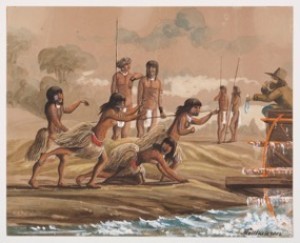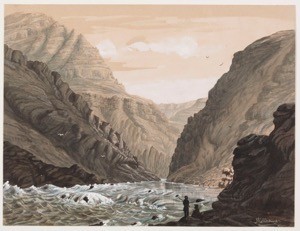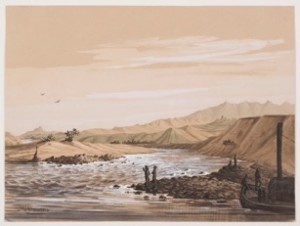By Dave Lewis
Lieutenant Joseph Ives and his men were awestruck when they entered the bottom of the Grand Canyon at Diamond Creek in March 1858.
Geologist Newberry studied the rock layers; cartographer Egloffstein and artist Möllhausen sketched; Ives used the language of architecture to describe “. . . stately facades, august cathedrals, amphitheaters, rotundas, castellated walls, and rows of time-stained ruins, surmounted by every form of tower, minaret, dome and spire . . .” He wrote evocatively of the sublime views and beautiful colors of the canyon.
 Leaving Diamond Creek, Ives probed possible access points to the river as he worked his way east. Finding none, he crossed Hopi land to Fort Defiance and disbanded his expedition.
Leaving Diamond Creek, Ives probed possible access points to the river as he worked his way east. Finding none, he crossed Hopi land to Fort Defiance and disbanded his expedition.
Ives’s legacy was an astonishingly thorough report richly illustrated with maps, topographical sketches, and paintings.
Newberry’s contribution “ . . . revealed the fabled canyons of the Colorado and the unknown Plateau Province to the scientific world . . . so that a geologic picture of the West was beginning to emerge. . .”
 Cartographer and topographer Egloffstein, with a camera lucida used previously by slain artist Richard Kern, invented a new process of illustrating topography, that, according to William Goetzmann: “. . . expressed the ruggedness of the country by adding a new illusion of depth and height.”
Cartographer and topographer Egloffstein, with a camera lucida used previously by slain artist Richard Kern, invented a new process of illustrating topography, that, according to William Goetzmann: “. . . expressed the ruggedness of the country by adding a new illusion of depth and height.”
Möllhausen, artist and natural history collector, gathered specimens of previously undocumented plants and animals. Indians helped in exchange for strings of beads. But one Indian who offered a lizard missing its tail received only half a string of beads.
Möllhausen’s paintings of the Indians provide the earliest and most authentic documentation of largely unknown peoples. His sketches of fossils and living plants and animals created a valuable natural history record, and his watercolors captured the splendor of the scenery.
Ives and his assistants meticulously documented the science of the river and Ives wrote narrative descriptions of the scenery. Goetzmann, on the report: “Though it was a scientific paper, all of the mannerisms of the romantic imagination are there . . . to present in terms of human experience just what it was like to go where no white man had ever gone before.”
 “The Ives expedition . . . had far-reaching consequences for the development of the Arizona Territory,” wrote Ben Huseman. “The Explorer reached completely uncharted portions of the Colorado River, and soon steamers regularly plied the river to a point near Black Canyon. In the 1860s, the Colorado became a major highway for supplying the Territory’s new capital at Prescott and the settlements that grew up when gold and silver were found . . . “
“The Ives expedition . . . had far-reaching consequences for the development of the Arizona Territory,” wrote Ben Huseman. “The Explorer reached completely uncharted portions of the Colorado River, and soon steamers regularly plied the river to a point near Black Canyon. In the 1860s, the Colorado became a major highway for supplying the Territory’s new capital at Prescott and the settlements that grew up when gold and silver were found . . . “
Ives is often dismissed for writing: “The region is, of course, altogether valueless. It can be approached only from the south, and after entering it there is nothing to do but leave. . . It seems intended by nature that the Colorado River, along the greater portion of its lonely and majestic way, shall be forever unvisited and undisturbed.”
Stephen Pyne suggests this was meant as a compliment to a region so majestic and sublime that it defied exploration and use. “Valueless,” lies in what Ives didn’t find: accessibility, arable land, or natural resources to exploit. He was right about that, but Newberry countered: “ . . . though valueless to the agriculturalist, dreaded and shunned by the emigrant, the miner and even the adventurous trapper, the Colorado Plateau is to the geologist a paradise.”
As for “unvisited and undisturbed,” Ives might be surprised in 2019 -- at the 100th anniversary of Grand Canyon National Park -- as more than six million visitors from around the globe come to see this extraordinary place.
This article was publsihed in The Daily Courier on March 27, 2019.
“Days Past” is a collaborative project of the Sharlot Hall Museum and the Prescott Corral of Westerners International (www.prescottcorral.org). This and other Days Past articles are also available at https://sharlothallmuseum.org/articles/days-past-articles.l. The public is encouraged to submit proposed articles and inquiries to dayspast@sharlothallmuseum.org. Please contact SHM Library & Archives reference desk at 928-445-3122 Ext. 2, or via email at archivesrequest@sharlothallmuseum.org for information or assistance with photo requests.


